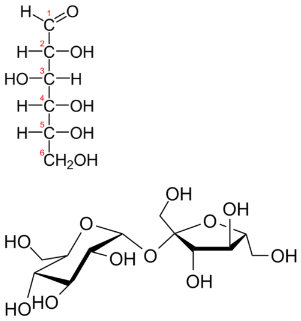5.9: Determining Molecular Formulas
- Page ID
- 409001
Below are two carbohydrates: glucose and sucrose. Sucrose is almost exactly twice the size of glucose, although their empirical formulas are very similar. Some people could distinguish them on the basis of taste, but it's not a good idea to go around tasting chemicals. The best way is to determine the molecular weights—this approach makes the compounds easily distinguishable.

Molecular Formulas
Molecular formulas give the kind and number of atoms of each element present in a molecular compound. In many cases, the molecular formula is the same as the empirical formula. The molecular formula of methane is \(\ce{CH_4}\) and because it contains only one carbon atom, that is also its empirical formula. Sometimes, however, the molecular formula is a simple whole-number multiple of the empirical formula. Acetic acid is an organic acid that is the main component of vinegar. Its molecular formula is \(\ce{C_2H_4O_2}\). Glucose is a simple sugar that cells use as a primary source of energy. Its molecular formula is \(\ce{C_6H_{12}O_6}\). The structures of both molecules are shown in the figure below. They are very different compounds, yet both have the same empirical formula of \(\ce{CH_2O}\).

Empirical formulas can be determined from the percent composition of a compound. In order to determine its molecular formula, it is necessary to know the molar mass of the compound. Chemists use an instrument called a mass spectrometer to determine the molar mass of compounds. In order to go from the empirical formula to the molecular formula, follow these steps:
1. Calculate the empirical formula mass (EFM), which is simply the molar mass represented by the empirical formula.
2. Divide the molar mass of the compound by the empirical formula mass. The result should be a whole number or very close to a whole number.
3. Multiply all the subscripts in the empirical formula by the whole number found in step 2. The result is the molecular formula.
The empirical formula of a compound of boron and hydrogen is \(\ce{BH_3}\). Its molar mass is \(27.7 \: \text{g/mol}\). Determine the molecular formula of the compound.
Solution
Step 1: List the known quantities and plan the problem.
Known
- Empirical formula \(= \ce{BH_3}\)
- Molar mass \(= 27.7 \: \text{g/mol}\)
Unknown
Steps to follow are outlined in the text.
Step 2: Calculate.
\[\text{Empirical formula mass (EFM)} = 13.84 \: \text{g/mol}\]
\[\frac{\text{molar mass}}{\text{EFM}} = \frac{27.7}{13.84} = 2\]
\[\ce{BH_3} \times 2 = \ce{B_2H_6}\]
The molecular formula of the compound is \(\ce{B_2H_6}\).
Step 3: Think about your result.
The molar mass of the molecular formula matches the molar mass of the compound.
Summary
- Molecular formulas give the kind and number of atoms of each element present in a molecular compound.
- A procedure is described for the calculation of the exact molecular formula of a compound.


